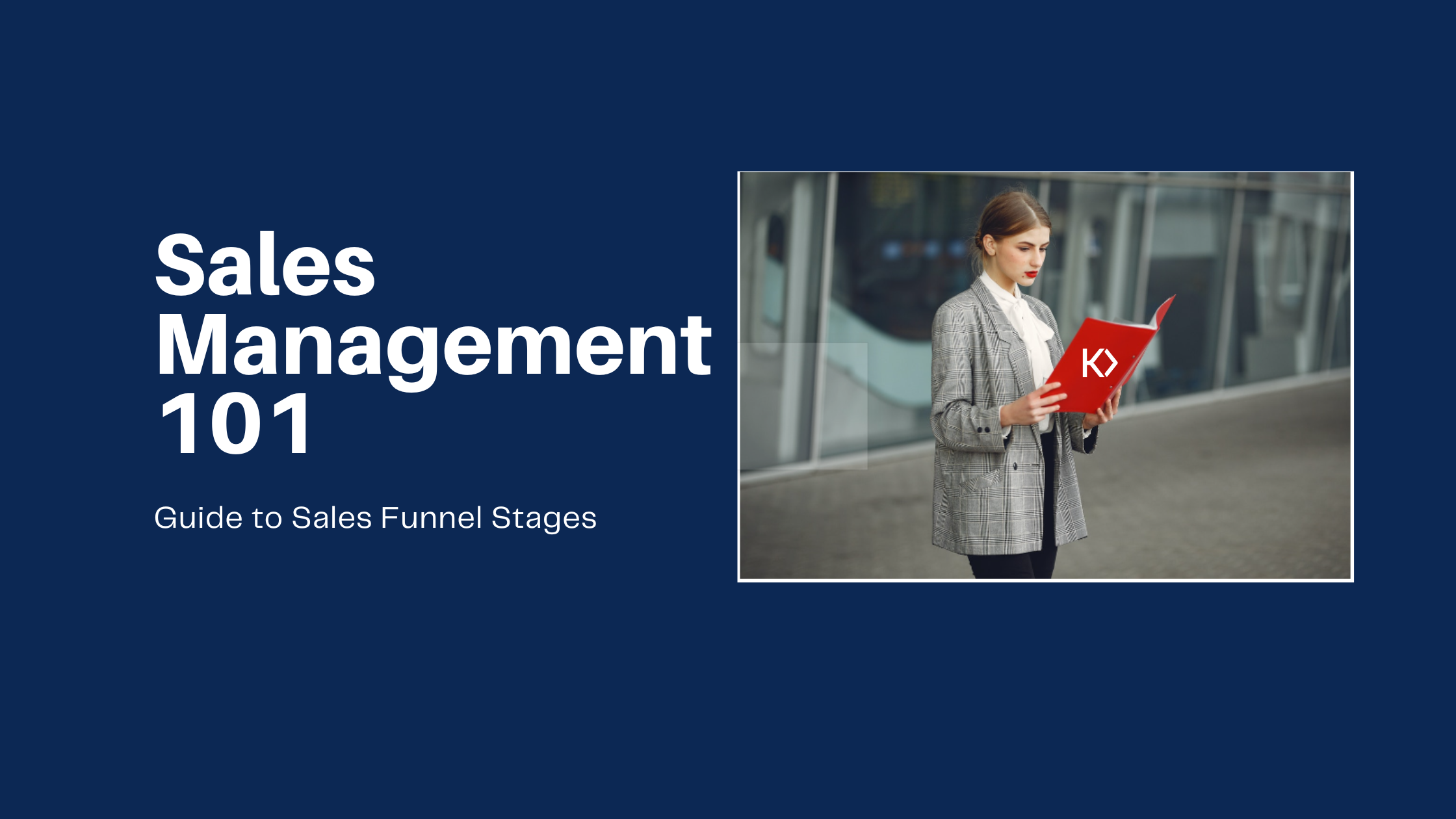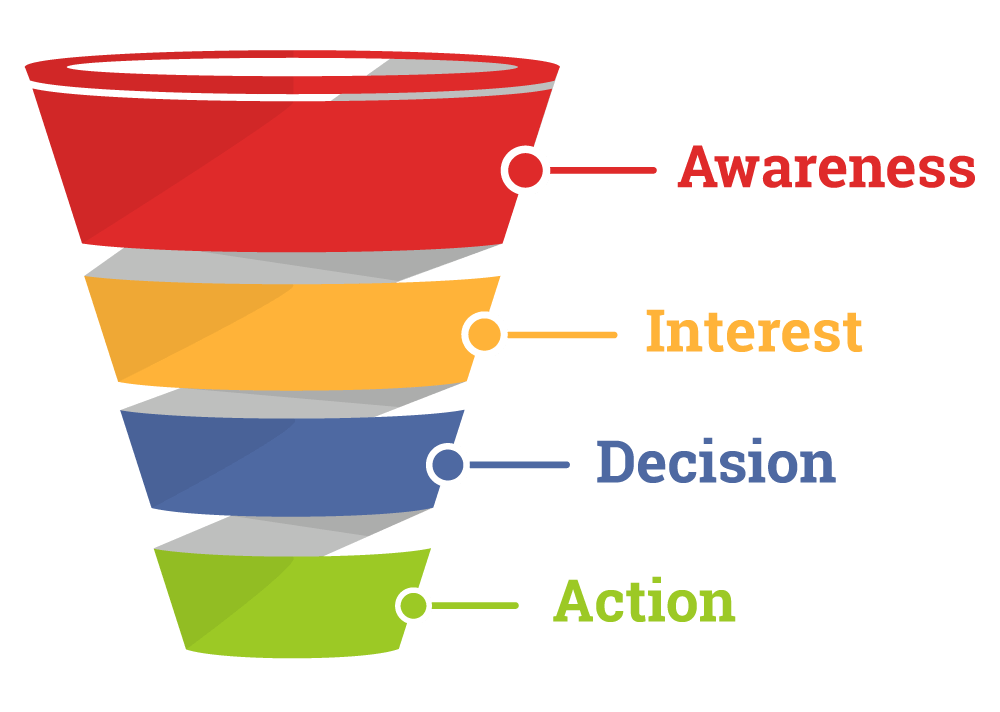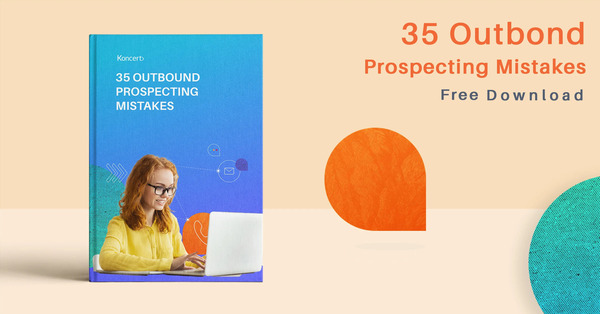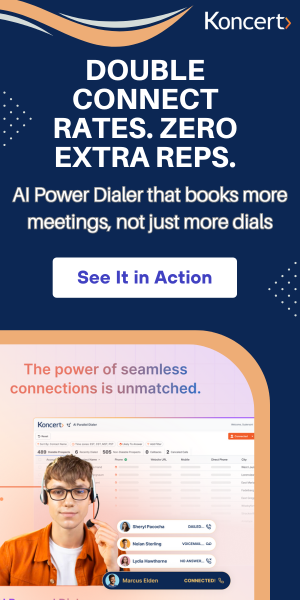9 min read
Sales Management 101: Guide to Sales Funnel Stages
By: Koncert Marketing on Jun 20, 2022 8:30:00 AM

What is the Sales Funnel?
At some point, every sales rep, no matter how good, has been hit with a bad surprise. Prospects drop out suddenly, good leads turn out to be poor fits, and some purchases just never happen.
What happened? How did that hot lead go away? Sometimes, it’s because they are in a different place within the sales funnel than the rep realized.
The sales funnel describes the customer journey. It both defines and visualizes the steps new leads take from initial awareness to their final purchase.
Aided by the right sales tools, a sales funnel offers valuable insights into customer behavior.
Sometimes referred to as a “marketing funnel,” the sales funnel is typically segmented into four or five stages. Although similar, this is not to be confused with the stages of a sales pipeline.
Pipelines focus on selling activities, whereas funnels focus on the prospect’s actions.
Both are important to the sales process, but today, we’ll be discussing the sales funnel.
We’ll explore the stages of a sales funnel, why you should manage your funnel, and tips to create an effective management plan. Let’s dive in!
Why Manage the Sales Funnel
The sales funnel is depicted as a funnel because prospective customers dwindle the closer they get to a purchase. It’s a painful yet unavoidable truth.
Fortunately, sales teams can capitalize on this knowledge.
By managing their sales funnel, teams deepen their understanding of why some prospects buy, and some don’t, and what were the triggers that moved them down the funnel towards a purchase decision, or what made them decide your product was not for them. Analyzing why some prospects stayed in the funnel, and why others didn’t, can potentially limit leakage going forward.
Sales teams may then:
- Better target your ideal customers: By learning more about your target audience’s needs, preferences, and pain points, sales teams can identify prospects who fit their buyer persona with greater precision.
- Identify predictable patterns: Selling isn’t an exact science, but the sales funnel does help pinpoint behavioral patterns.
Reps can capitalize on these patterns to refine their strategies. They may also leverage a degree of predictability when appealing to their customer’s habits.
- Allow for targeted efforts: In addition to identifying best-fit prospects, sales teams increase their efficiency, by spending less time on poor leads and focusing more on personalizing outreach for the leads that are likely to convert.
- Increase conversion rates and revenue: Prospects will always fall out of the funnel, but salespeople who know their customers’ needs can optimize their pipeline to keep winnable deals from falling through the cracks.
- Boost lifetime value: Businesses have a 60% to 70% chance of selling to an existing customer, yet only a 5% to 20% chance of selling to a new customer.
By harnessing the right insights from their funnel, reps can use their knowledge to build stronger customer relationships, encourage future sales opportunities, and improve retention with prospects who choose to purchase.
The Four Sales Funnel Stages

[Source]
As previously mentioned, each stage of a sales funnel corresponds to the customer journey. For every lead that enters, they either progress to the next stage until they make a purchase or drop out of the funnel.
How the funnel is visualized depends on your company’s sales model. Below, we’ll explore the different stages of the sales funnel in four steps.
Awareness
The awareness stage, also known as the top of the funnel, is where potential customers first become aware of your products or services.
Awareness is generated through marketing efforts such as:
- Content marketing
- Email marketing
- Offline advertising
- Social media
- Word of mouth
- Referral programs
As you’re developing awareness, this stage of the funnel will help pinpoint where you’re most likely to reach your target audience.
For example, do your prospects prefer LinkedIn or in-person networking? If it's the former, do they respond better to cold emails or paid advertisements on LinkedIn?
By answering these questions, your team can adjust their prospecting and lead generation processes to the right marketing channels.
Interest
The interest stage is where new leads explore their interest in your business. They’ll consider the challenges they face and research proposed solutions from you and fellow competitors.
Although every customer is unique, they’ll share brand preferences. Therefore, it’s vital that you have the right content and incentives in place to grab their attention.
A lead magnet on a landing page can capture their interest while articulating your business’s value. This is where the differences between your product and your competitors need to be clarified and your product’s value needs to be made clear.
Your landing page may offer a free demo, e-book, or similar content in exchange for contact information. The initial offer will educate them while allowing you to forward other incentives to keep them engaged (usually via an email campaign).
The more information you have on prospects, the easier it will be to generate the right messaging and hold their interest.
Decision
The decision stage of your sales funnel is where potential customers decide on a purchase. As with the interest stage, prospects will continue to weigh their options until they’re ready to select a product or service.
To win them over, you need to know what questions they’ll be asking about particular features and benefits within your product. Make sure there are landing pages and plenty of content on your website, where they’ll find actionable documentation reaffirming the effectiveness of your product or solution.
The type of content you produce depends on your business. Some examples include:
- Testimonials
- FAQ pages
- Infographics
- Case studies
- Whitepapers
- Webinars
If in direct contact with prospects, salespeople must stay engaged without being pushy.
Although this is a fine line to walk, research shows that 44% of sales reps stop pursuing leads after only one follow-up call—yet 60% of customers will say yes after four no’s.
Furthermore, you might win customers over by offering something your competitors aren't, such as flexible pricing plans or better onboarding processes. Study the funnel to better determine what gives you an edge over competitors.
Action
The action stage represents the bottom of the funnel and the end of the buying process. Here, prospects act. They either make a purchase or exit out of the funnel.
If they decide to purchase, they become part of your business’s ecosystem, kickstarting the customer relationship.
To reaffirm the buyer’s confidence and boost customer retention, sellers must stay engaged. They should provide a seamless onboarding process and deliver a positive customer experience at every point of contact.
In doing so, they help create stronger connections with buyers, generate opportunities for cross-selling or upselling, and encourage brand loyalty.
Additionally, when prospects leave the funnel, there is a chance to recover the deal.
By collecting their information earlier in the funnel, lead nurturing campaigns may bring previously unqualified leads back into the sales cycle and achieve a purchase.
Creating a Sales Funnel Management Plan
Just as with the sales pipeline, the sales funnel is not a simple end-to-end process.
Prospects will drop out at any stage and sellers have no control over final purchasing decisions. However, they can control how they approach the funnel within their management plan.
By creating a sales funnel management plan, sales teams can identify bottlenecks, prevent leaks of perfect-fit prospects, refine funnel stages to improve conversion rates, and much more.
To help you get started, we’ve put together some tips for creating a plan:
- Set clear goals: Setting objectives should be the first step. Not only do objectives cement your hopes for the funnel, but they help keep teams focused and motivated.
- Establish a manageable timeline: Although every funnel is unique, a lengthy or rushed funnel has a higher chance of leaking leads.
Define your most effective touchpoints, then establish a timeline that engages and educates—but neither rushes nor takes a lot of time out of a prospect’s day.
- Track leads with KPIs: Keep track of vital customer details in your CRM and integrate with other tools to improve lead generation.
By expertly managing key information on leads, your team can make data-backed decisions to optimize the funnel.
- Continuously measure progress: Keep your team on track by monitoring their progress and interactions.
In doing so, you may gain valuable insights to help guide your team.
Efficiently Manage Your Sales Funnel with Koncert
The sales funnel helps define the customer journey, visualizing the steps prospective customers take towards a purchase.
By defining and managing the funnel, teams can discover critical information to decrease leakage, identify best-fit prospects, and build stronger customer relationships.
To help manage your sales funnel, Koncert provides a variety of products to support sales teams.
Develop your plan and employ cadences to target specific stages of the funnel. Utilize sales automation and multi-channel workflows to streamline communication. Scale your efforts across the funnel with easy-to-use human-assisted dialers, sales metrics, and even AI-supported Coverage.
Invest in the right strategies and schedule a demo today with Koncert to learn more.
Related Posts
14 min read
AI-Powered vs. Agent-Assisted - The Right Dialer for Your Sales Team
Aug 29, 2025 by Koncert Marketing



